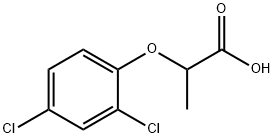2,4-DP is a combustible, colorless to yellowishto tan crystalline solid with a faint phenolic odor; Molecularweight=235.07; Freezing/Melting point=117-118℃.Soluble in water; solubility=350 mg/L at 20℃. HazardIdentification (based on NFPA-704 M Rating System):Health 2, Flammability 0, Reactivity 0. May be applied as aliquid formulated with a flammable carrier, which can alterthe physical properties listed here.
2,4-DP is a combustible, colorless to yellowish
to tan crystalline solid with a faint phenolic odor
Dichloroprop is a herbicide used for the post-emergence control of annual and perennial broad-leaved weeds and some brush species.
ChEBI: An aromatic ether that is 2-hydroxypropanoic acid in which the hydroxy group at position 2 has been converted to its 2,4-dichlorophenyl ether.
Yellowish to colorless solid. Soluble in organic solvents. Used as an herbicide.
Dichlorprop is an organic acid. Neutralizes bases in exothermic reactions.
Suspected carcinogen.
Poison by ingestion. Moderately toxic by
skin contact. An experimental teratogen.
Other experimental reproductive effects.
Mutation data reported. A fumigant. When
heated to decomposition it emits toxic
fumes of Cl-.
If this chemical gets into the eyes, remove anycontact lenses at once and irrigate immediately for at least15 min, occasionally lifting upper and lower lids. Seek medical attention immediately. If this chemical contacts theskin, remove contaminated clothing and wash immediatelywith soap and water. Seek medical attention immediately. Ifthis chemical has been inhaled, remove from exposure,begin rescue breathing (using universal precautions, including resuscitation mask) if breathing has stopped and CPR ifheart action has stopped. Transfer promptly to a medicalfacility. When this chemical has been swallowed, get medical attention. Give large quantities of water and inducevomiting. Do not make an unconscious person vomit.
The average field half-life is
10 days. Microbial degradation and plant uptake account
for the short half-life of dichlorprop. Losses due to leaching,
photodegradation, and volatilization are minimal.
Chemical. Dichlorprop and its salts are very stable, but
esters readily hydrolyze under acidic and basic conditions.
Plant. Degradation of the side chain of dichlorprop to
form 2,4-dichlorophenol is most common. Dichlorprop may
be conjugated to form glucosides, diglucosides, and to a
limited extent triglucosides.
Soil. The degradation pathway of dichlorprop is similar
in plants and soils, forming 2,4-dichlorophenol. Evidence
indicates that some microbial communities preferentially
degrade the R-enantiomer.
Color Code—Blue: Health Hazard/Poison: Storein a secure poison location. Prior to working with 2,4-DPyou should be trained on its proper handling and storage.Store in tightly closed containers in a cool, well-ventilatedarea away from strong oxidizers and bases. Metal containersinvolving the transfer of this chemical should be groundedand bonded. Where possible, automatically transfer materialfrom drums or other storage containers to process containers. Drums must be equipped with self-closing valves, pressure vacuum bungs, and flame arresters. Use onlynonsparking tools and equipment, especially when openingand closing containers of this chemical. Sources of ignition,such as smoking and open flames, are prohibited where thischemical is used, handled, or stored in a manner that couldcreate a potential fire or explosion hazard. Wherever thischemical is used, handled, manufactured, or stored, useexplosion-proof electrical equipment and fittings.
UN3345 Phenoxyacetic acid derivative pesticide,
solid, toxic, Hazard Class: 6.1; Labels: 6.1-Poisonous
materials
Crystallise 2,4-DP from MeOH. It is a plant growth substance, a herbicide and is TOXIC. The R(+)-and S(-)-enantiomers have m 124o (from *C6H6) and [�] D ±35.2o (c 1, Me2CO). [Beilstein 6 H 189, 6 III 708, 6 IV 922-923.]
Mammalian Toxicity. Dichlorprop appears to be excreted
unchanged in animals. The acute oral LD50s of dichlorprop
in rat and mice are 825–1470 mg/kg and 400 mg/kg,
respectively.
Dust may form explosive mixture with
air. Contact with oxidizers may cause a fire and explosion
hazard. The aqueous solution is a weak acid. Attacks many
metals in presence of moisture. Compounds of the carboxyl
group react with all bases, both inorganic and organic (i.e.,
amines) releasing substantial heat, water and a salt that
may be harmful. Incompatible with arsenic compounds
(releases hydrogen cyanide gas), diazo compounds, dithiocarbamates, isocyanates, mercaptans, nitrides, and sulfides
(releasing heat, toxic and possibly flammable gases),
thiosulfates and dithionites (releasing hydrogen sulfate and
oxides of sulfur).
In accordance with
40CFR165, follow recommendations for the disposal of
pesticides and pesticide containers. Must be disposed properly by following package label directions or by contacting
your local or federal environmental control agency, or by
contacting your regional EPA office.

